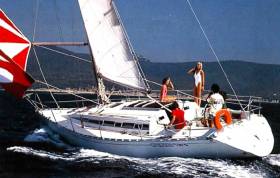Displaying items by tag: First 375
A First 375 has appeared on Afloat's Boats for Sale this week and there’s a timeless elegance to the general appearance and lines of the First 375 which suggests something beyond basic naval architecture in her creation writes W M Nixon. So it’s no surprise to learn that designer Jean Berret was a student at a very distinguished art school before his love of sailing, and offshore racing in particular, steered him into the professional designing of boats which he’d like to sail himself, and in 1985 the First 375 for Beneteau was signed off from his drawing board.
This 1988-built First 375 is based in Howth Yacht Club Marina, and is for sale through Leinster Boats. She certainly seems to have done what’s expected of her, as she has had only two previous owners. But as she is largely unchanged from new – including the original 28hp Volvo Penta diesel auxiliary – her sensible price of €31,950 reflects this, as some potential owners might think in terms of an early engine upgrade for this 28-year-old boat, planning on installing a more powerful yet lighter type of motor.
Against that, I was with a couple of happy co-owners on another cruiser of a certain age the other day who still cruise with their original vintage Volvo, and they wouldn’t dream of having anything else. Its weight gives it endurance, and it’s tops on fuel consumption too – “It would run on the smell of an oily rag” I was assured.
In this version of the First 375, the accommodation has been so arranged that you could sleep eight if needs be, but as there’s only one toilet that might feel a little crowded, and a more civilized approach would be no more than six with the saloon settee berths used only as settees. For four, she would be decidedly commodious, a very civilised fast cruiser which could give a good account of herself in local racing. As for her looks, you’re almost into “Spirit of Classics” territory here, she looked good when she was new, and she still looks good.
Read the full advert on Afloat's Boats for Sale here
Lively Lady is ISORA Rockabill Race Winner
East Coast inshore campaigner Lively Lady (Derek Martin) left Dublin Bay racing behind yesterday for ISORA's offshore race to Rockaill and won. The Royal Irish boat, a Beneteau First 44.7, topped a 13-boat fleet over the 50 mile course to Rockabill. It was the second ISORA race of the 2011 calendar.
Second overall was another Beneteau, Walter Mitty, Stephen Mullaney's First 375 from Howth Yacht Club. Third was Jedi, Andrew Sarratt's J109 from Dun Laoghaire.
Yesterday's race was a much more pleasant start to the season compared to the previous weekend's pasting taken during the slog across the Irish Sea to Holyhead. Perhaps that was the reason for the drop off in entries from 21 to 13? Next Saturday's ISORA fixture features another cross Irish Sea venture, this time to Pwhelli.
Race two results are available for download below. Latest ISORA news here.
ISORA Commodore Peter Ryan adds:
It had been hoped that there would be a bumper fleet out for this popular day race run in conjunction with the Royal Alfred Yacht Club and the Lee Overlay Offshore Series but despite 25 entries, only 15 came to the start line. The heavy offshore race to Holyhead and delivery back the previous weekend and the strong winds all the week since then, had taken its toll with damage to boats and crew and boats not being to get to Dun Laoghaire.The weather forecast for the day was for wind force 3-5 south east going east. The original course was to go south to North Arklow buoy. However, with the strong spring tides going north at the start and the light winds forecast, the Sailing Committee decided that going north to Rockabill would ensure a finish would be achieved to all boats. The course was: Start – North Burford(P) – Lambay (P) – Rockabill (S) – Lambay (S) – Kish Light (S) – Finish at Dun Laoghaire Harbour (45 miles).
Paul McCarthy of the RAYC provided the start at 10.00 and the fleet set off on a white sail reach towards North Burford. The wind was as forecast, south east force 3-4. Rounding that mark, spinnakers were raised and the fleet sped north with the tide. Shorthy after 12.00 “Lively Lady” rounded Rockabill followed by “English Mick”, “Orna” and directly behind her “Tsunami”.
The leg back to Kish was a beat keeping Lambay to starboard. The wind fluctuated with the stronger wind being out to sea. Most boats tacked behind Lambay to get the benefit of some lack tides in the lee of the island.
The wind was holding as the fleet neared Kish. First round was “Lively Lady” followed by “English Mick”, “Tsunami”, “Orna” and “Jedi”. As forecast the wind backed to east and dropped. What was looking like a charge to the finish turned out to be a crawl. Many of the boats at the back of the fleet gained by a temporary filling of the wind from behind as they caught up with the leading pack. However, “Lively Lady” and “English Mick” held their positions and crossed the line first and second. “Jedi” and “Orna” crept past “Tsunami” to cross the finish.
“Lively Lady” took line honours, 1st in Class and 1st Overall. “Jedi” took 1st in Class 2 while “Walter Mitty” won Class 3.
Sandra Moore of the NYC provided the finish. The usual après sail took place in the NYC after the race.
The next race is the Day Race in Pwllheli on the 14th May. It is hoped that the day race there will attract some new entrants from the Welsh side.
| Rank | Fleet | Boat | SailNo | Type | Rating | Start | Finish | Elapsed | Corrected | Points |
|---|---|---|---|---|---|---|---|---|---|---|
| 1 | Class 1 | Lively Lady | IRL 1644 | First 44.7 | 1.109 | 10.00.00 | 16:21:00 | 6.21.00 | 7.02.32 | 98.6 |
| 2 | Class 3 | Walter Mitty | IRL 7963 | First 375 | 0.947 | 10.00.00 | 17:36:38 | 7.36.38 | 7.12.26 | 92.8 |
| 3 | Class 2 | Jedi | IRL 8088 | J109 | 1.029 | 10.00.00 | 17:05:15 | 7.05.15 | 7.17.35 | 87.0 |
| 4 | Class 1 | Orna | IRL 532 | 1.047 | 10.00.00 | 17:13:18 | 7.13.18 | 7.33.40 | 81.2 | |
| 5 | Class 2 | Lula Belle | IRL 3607 | First 36.7 | 1.019 | 10.00.00 | 17:28:55 | 7.28.55 | 7.37.27 | 75.4 |
| 6 | Class 3 | Windshift | IRL 37737 | SF37 | 0.992 | 10.00.00 | 17:41:59 | 7.41.59 | 7.38.17 | 69.6 |
| 7 | Class 2 | First of September | IRL 8581 | First 43.5 | 1.017 | 10.00.00 | 17:32:41 | 7.32.41 | 7.40.23 | 63.9 |
| 8 | Class 1 | Tsunami | IRL 4007 | First 40.7 | 1.061 | 10.00.00 | 17:15:00 | 7.15.00 | 7.41.32 | 58.1 |
| 9 | Class 1 | English Mick | GBR4771R | Beneteau 47.7 | 1.130 | 10.00.00 | 16:50:07 | 6.50.07 | 7.43.26 | 52.3 |
| 10 | Class 2 | Miss Scarlett | IRL 4763 | Sunfast 40.3 | 1.025 | 10.00.00 | 17:33:06 | 7.33.06 | 7.44.26 | 46.5 |
| 11 | Class 3 | Yahtzee | IRL 1068 | Oceanis 411 | 0.983 | 10.00.00 | 17:57:51 | 7.57.51 | 7.49.44 | 40.7 |
| 12 | Class 1 | Sailing West Intuition | GBR 9383 | Reflex 38 | 1.060 | 10.00.00 | 17:28:33 | 7.28.33 | 7.55.28 | 34.9 |
| 13 | Class 1 | Rebellion | IRL 6001 | Nicholson 58 | 1.054 | 10.00.00 | 17:39:22 | 7.39.22 | 8.04.10 | 29.1 |
| 14 | Class 1 | African Challenge | IRL 2649 | Fast 42 | 1.077 | 10.00.00 | 17:33:11 | 7.33.11 | 8.08.05 | 23.4 |
| 15 | Class 3 | Obsession | IRL4513 | Sigma 33 | 0.905 | DNF | 10.0 |






























































